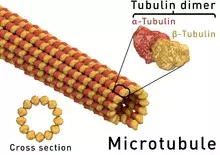Published on 30.07.2025
All cells have a cytoskeleton of microtubules, a complex network of interwoven fibers that maintain their structure, help them divide and enable the movement of intracellular elements by acting as transport pathways. They also provide the backbone for cilia, the fine filaments on the surface of the cell, acting as sensory antennae to detect environmental signals, or as motorized paddles to move the cell or nearby fluids. The coordinated movements generated by these mobile cilia are essential, for example, to the lateralization of organs during embryonic development, the movement of mucus in the respiratory tract, the circulation of cerebrospinal fluid in the brain, or the movement of sperm and eggs, thus contributing to fertility.
Microtubules are hollow cylindrical structures formed by the assembly of alpha and beta tubulins: in humans, there are 9 types of alpha tubulin and 10 types of beta tubulin, creating a great diversity of microtubules. The diversity of tubulins and their modifications is thought to control the properties and functions of the microtubule cytoskeleton, a concept known as the “tubulin code”.
Each tubulin is encoded by a distinct gene, and genetic mutations have been discovered in the vast majority of them. Surprisingly, these mutations specifically alter the intracellular tubular network, without altering that of the cilia, and lead to circumscribed deficits affecting mainly the brain, and more rarely other organs.
Why do these diseases, which affect an essential structural component of all cells, affect only one or a few organs or tissues, and why have no defects been identified in the cilia that make them up?
Recent advances published in the prestigious journal Science shed light on this question. This research builds on initial work carried out at the Institut Imagine in 2017, aimed at resolving cases of childhood cecic deafness, which led to the identification of the first mutations in the beta 4B tubulin gene TUBB4B. Surprisingly, following these initial results, new mutations affecting this same beta 4B tubulin were discovered in patients with primary ciliary dyskinesia (PCD): PCD is a disease of the motile cilia manifesting variably in progressive deterioration of lung function, accumulation of fluid in the brain (hydrocephalus), abnormal arrangement of thoracic and/or abdominal organs (heterotaxy) and/or infertility.
Even more surprisingly, other mutations in the TUBB4B gene have been identified in patients suffering from PCD associated with cecic deafness, but also with renal, bone and/or cardiac symptoms, suggestive of a possible impact on non-mobile cilia too.
Intrigued by this discovery, 80 experts from 20 institutes around the world were brought together by Isabelle Perrault, a researcher in the Ophthalmological Genetics Laboratory headed by Jean-Michel Rozet at the Imagine Institute, and Pleasantine Mill, head of a research group at the Human Genetics Unit at the University of Edinburgh. The work carried out in particular by Sabrina Mechaussier and Daniel Dodd, respectively a PhD student in Paris and a post-doctoral fellow in Edinburgh, revealed that beta 4B tubulin is above all a key component of the ciliary framework. The clinical differences observed in patients stem from the impact of their mutation on the assembly and/or stability of intracellular and ciliary microtubules.
These discoveries not only mark a decisive step towards confirming and understanding the concept of the “tubulin code”, but also reveal the greater-than-expected complexity of the mechanisms behind the diversity of tubulin-associated diseases. They also underline the crucial importance of collaboration between researchers, rare disease clinicians, patients and their families. This collaboration not only improves the management of tubulin-related diseases, but also enriches our knowledge of cell biology, opening up new avenues for the development of innovative therapies.
Finally, by a coincidence of timing, by highlighting the central role of beta 4B tubulin in the formation of motile cilia, essential for organ lateralization during embryonic development, including in the development of cerebral asymmetry, these discoveries shed light on the link between certain variations in the sequence of the gene encoding TUBB4B and the probability of being born left-handed, which has just been reported in the journal Nature communication.
Reference:
Ciliopathy patient variants reveal organelle specific functions for TUBB4B in axonemal microtubules
Corresponding authors : Isabelle Perrault, Pleasantine Mill
DOI: 10.1126/science.adf5489 / URL: http://www.science.org/doi/10.1126/science.adf5489

